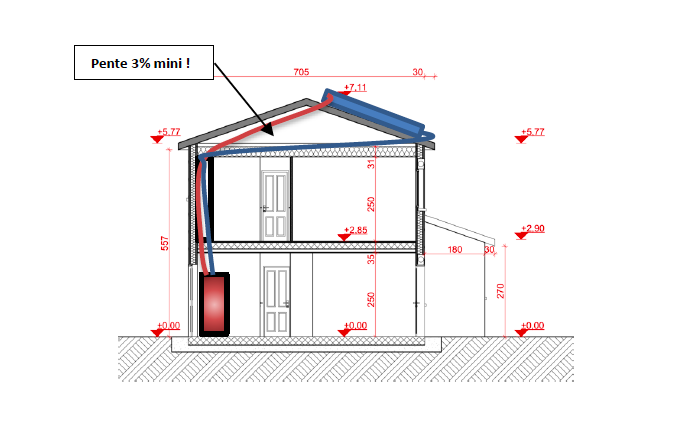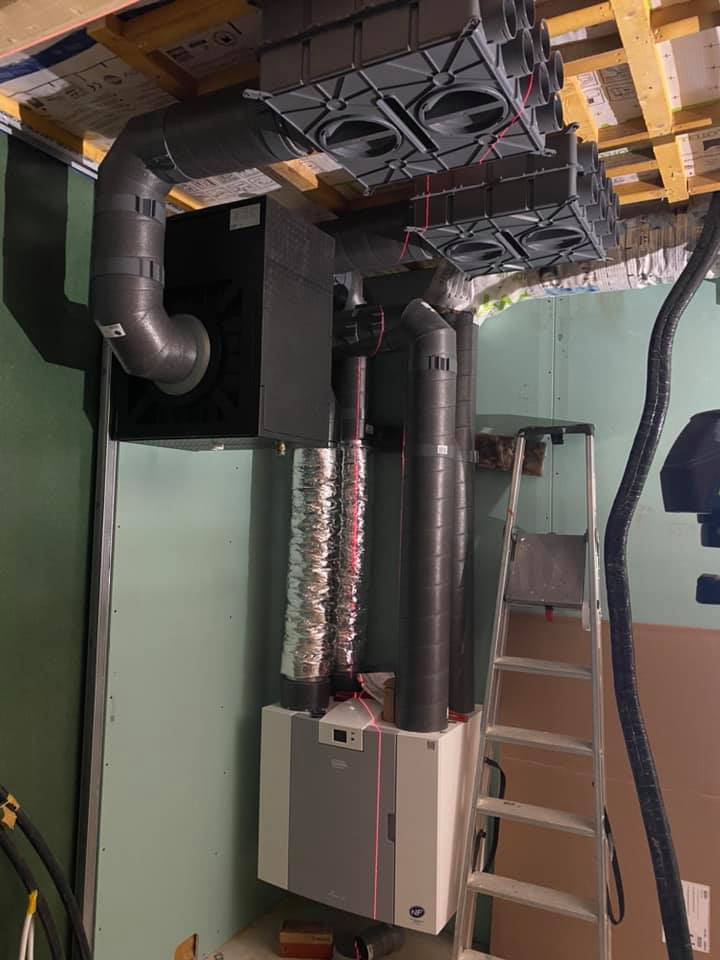Self-building a wooden passive house: testimony of Mathilde and Julien
Self-building a wooden house: a slightly crazy or accessible project?
Behind the desire to "physically" create one's home, what are the steps to be respected, the keys to success?
Take advantage of the advice of auto-entrepreneurs: Mathilde and Julien, who launched in 2020.
- The project holders
- The passive level, timber frame house
- The project preparation
- The timing of the construction
- The budget
- The funding
- 10 tips for self builders
Who are they?
Mathilde has turned 30. She is undergoing professional reconversion. A former art director and graphic designer, she took over her parents' wine business, Château de Vareppe, in the Bugey.
The place also hosts a number of events.
The place also welcomes groups to taste the family wine while enjoying a pig cooked in the fireplace.
Julien, 35, is a maintenance technician for the CNR (mechanical, electrical and hydraulic).
A few years ago, they used to ride motorbikes, on rides for the lady but also in trials competitions for the gentleman.
Lovers of trekking (Nepal, Argentina), they now enjoy more "natural" leisure activities: hiking, climbing, gardening.
They have already renovated their house, and are now in the process of doing so.
They have already renovated a stone stable. It took them 6 years to finish this first project, to transform it entirely into a house. Everything had to be created, roof, electricity, water, carpentry, etc.
This has allowed them to make a lot of money.
This allowed them to learn the basics, helped by Julien's father.
What is their project?
For this new adventure, they decided to build, not renovate: too heavy, too long, too many surprises.
Adapting to the existing and staying with "rough" materials (stone, cement) are the main reasons for not going back to a renovation.
To change from stone, the project went to a wooden house.
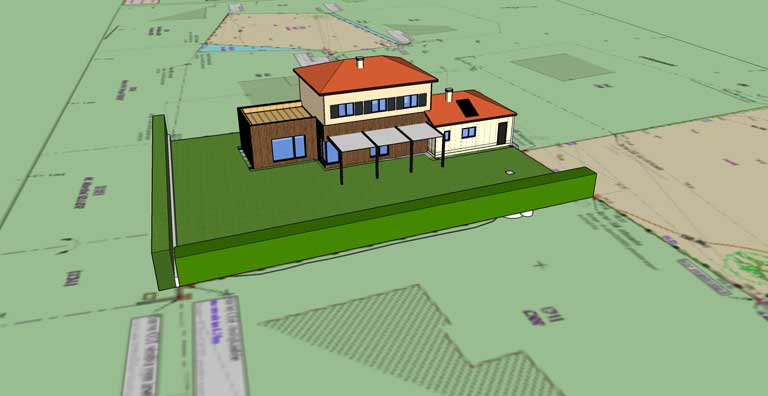
Why a timber-frame house?
- The natural, warm feel of wood
- "Easy" material, manageable and allows for quick assembly
- Energy efficient (passive house)
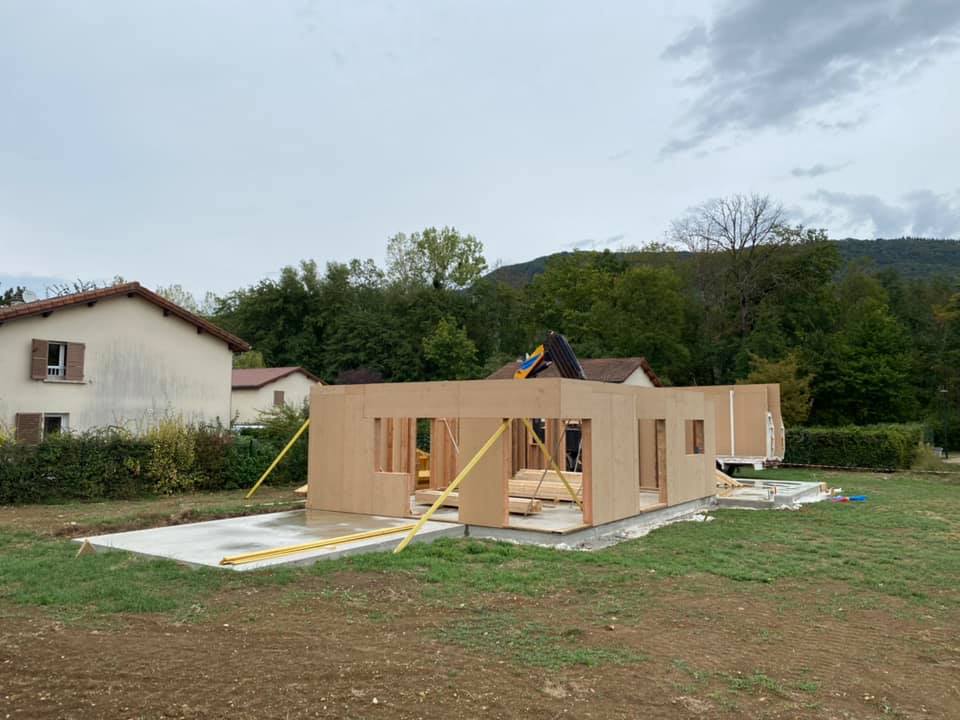
To illustrate the energy efficiency of the house, the aim is to use, only, between 0.5 and 1.5 steres of wood per year.
To carry out this project, Julien obtained 4 months of availability thanks to the time savings account set up in his company. He was therefore able to focus on the work from October 2020 to the end of January 2021.
For his part, the Matheson Matheson team is working on the project.
For her part, Mathilde also took advantage of the period after the harvest to participate fully in the construction.
General characteristics of the wooden house
- House: timber frame, on 2 levels + garage of 50m².
- Foundation: Concrete slab on cellular glass (MISAPOR)
- Heating system: log stove
- Insulation: wood wool, wadding
- Paint: VOC-free paint
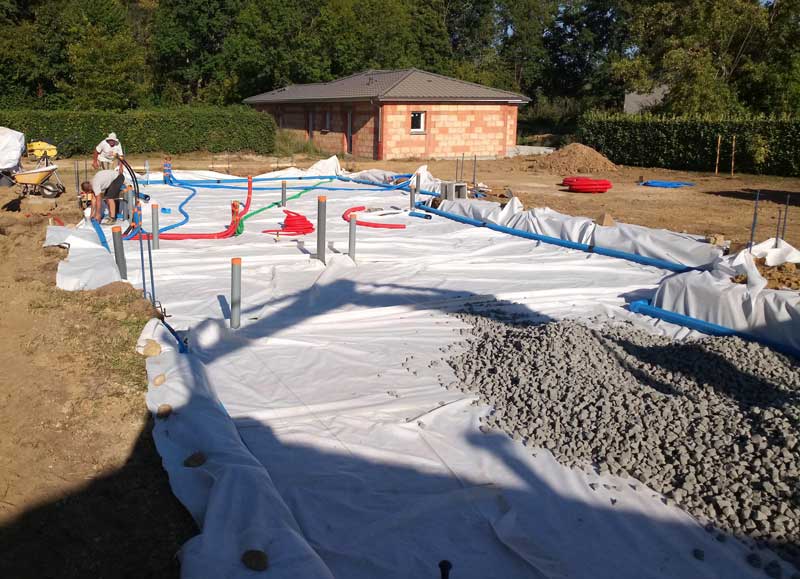
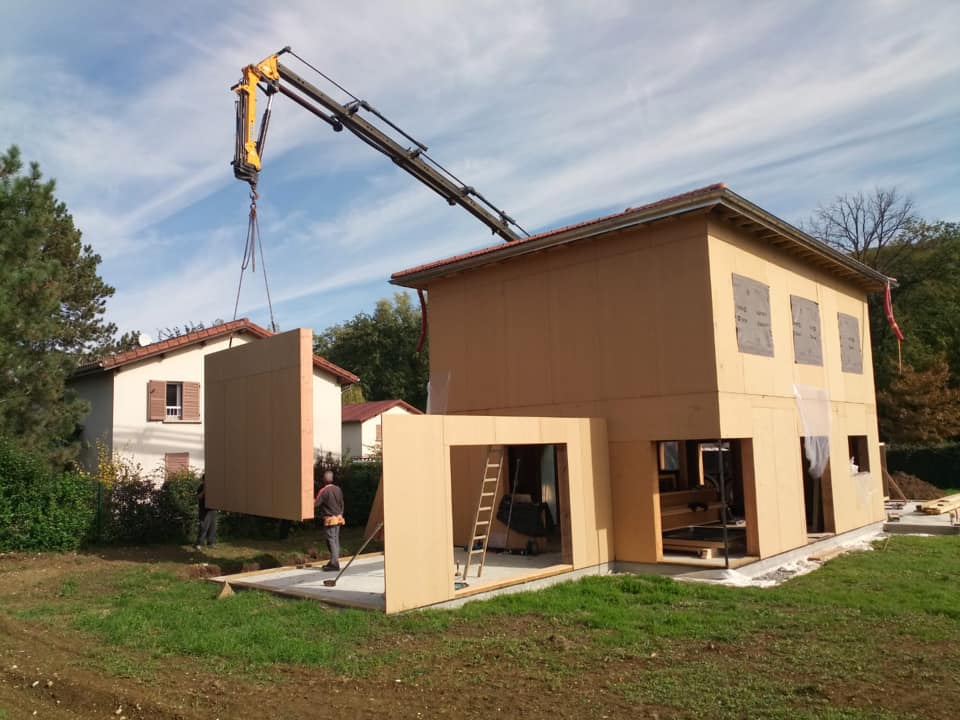
- Ventilation system: Double-flow ventilation with Canadian wells brink climate system.
- Joinery: Triple glazing
- Solar hot water: solar-thermal system HelioFrance
- Rainwater harvesting: concrete tank, intended for the use of rainwater for the toilet and the garden (and maybe the shower)
- Roof: flat, vegetated and clay tile
How did they prepare the project
Joining the Rhône Alpes Beavers
Julien has become an active member of this association. Its aim to promote and help self-builders of houses.
Participatory building sites
As members of the Beavers, Mathilde and Julien took part in concrete workcamps upstream of their project.
They were able to exchange with other self-builders: experience, good plan, galley.
Open house day: Visit of passive houses
They were also able to meet owners of passive houses. On this occasion, they began to determine certain choices (wooden house, passive level).
They also had the opportunity to meet owners of passive houses.
For the record, the threshold to reach the passive level: to have a heating need < at 15 KWh per year per m². Compared to a BBC dwelling, this represents 2 times less heating energy (and 4 times less energy in total, including household appliances). source guide de lamaisonpassive.fr
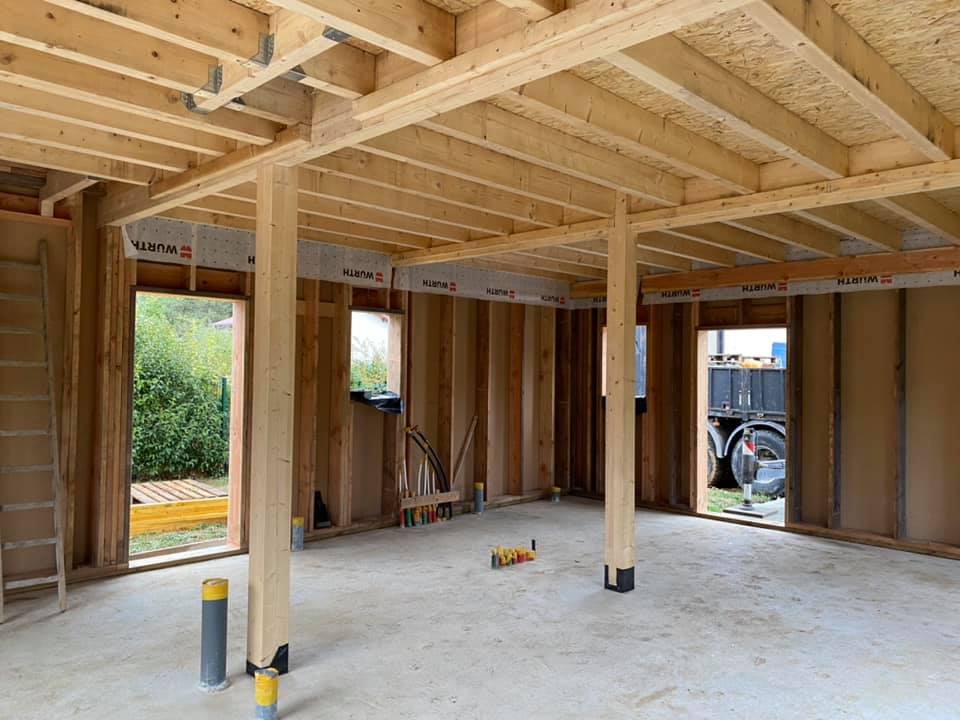
Participation in the PASSIBAT show
Julien went to the Passibat, in spring 2019. A majority of the technical choices were validated on site, after seeing the products. For example, the decision to use cellular glass for the foundations was taken in discussion with the manufacturers at that time. The same goes for the joinery.
Accompanied by his father in 2019, they gathered a lot of information beforehand, got a lot of answers from manufacturers on the different stands.
This allowed them to pass a stage, eliminating some solutions and thus refining the project.
The preparation of the project with Lacentrale-eco
Julien contacted us because he wanted a quote for a Heating-water-solar-thermal HelioFrance.
.Julien and Mathilde are building a passive house, so we offered to help them with their HVAC system:
. Sizing, supplying the complete system with a Passiv Haus certified ventilation system from Brink with electrically heated vents and a hydraulic Canadian well.
We provided them with a detailed quotation accompanied by a 2D plan with position of the vents, the VMC, sizingof the flow rates, passage of the networks and the installation instructions.
This helped to validate the position of the elements in the volume and the final shopping list. The material could finally be delivered directly to the site.
. Contact Lacentrale-ecoChoice of the thermician
Jean Luc DELPONT, from the company HELIASOL, was involved even before the signing of the compromise on the land.
An aerial view enabled him to give an initial positive opinion (possible positioning of the house in relation to sunlight as a priority)
This opinion was then confirmed physically. He made sure that there were no other constraints that would bring a lot of shadows: trees, neighbouring houses, etc.
Use of modelling tool
Mathilde and Julien used Sketchup. Some of it is free.
They were able to virtually design and visualise the house. This allowed them to validate certain technical choices. But also to anticipate unpleasant surprises.
They were able to design and visualize the house virtually.
For example, the 3D plans allowed them to choose the right model of stove: Visualising the stove beforehand, with its flues and outlets, allowed them to make the right choices of materials.
The modelling of the VMC was imagined with this tool.
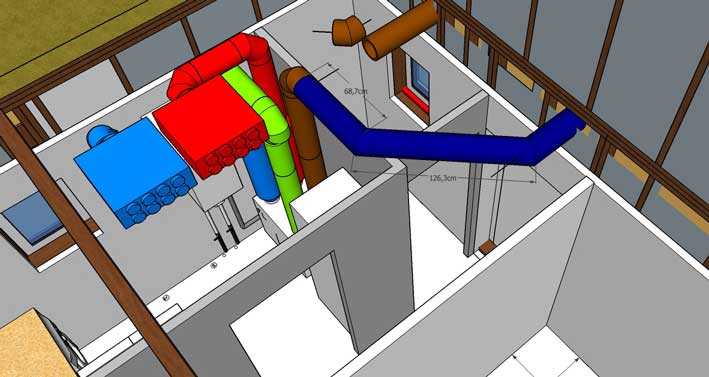
Please allow, at a minimum, 6 months preparation time. And to try to really anticipate and plan for everything, 12 to 18 months of preparation is needed.
How long does construction take?
Oct 2019 Signing Compromise land
Early 2019 First technical decisions and choice of design (flat roof, central part upstairs, large garage on the side)
Late 2019 Call for architect to bring in new ideas (integration of stove and staircase) + help with planning permission
Feb 2020 Application for planning permission, well slowed by containment
July 2020 Signing of the land
August 2020 Beginning of dirt. Foundation with cellular glass to insulate (no thermal bridge)
Seven 2020 Carpenting (assembly of the wooden walls), in 6 days only with the company Wooden Bridge
May 2021 End provisional main works and move in
.
What is the budget for the construction?
Building a passive house does not qualify for specific grants.
Officially, it is recognised at the same level as an RT 2012 house. On the other hand, they decided to make a house "physically" of a passive level. But without passing the corresponding certification: too many constraints and extra costs.
They set themselves a budget of 230,000.
A passive house requires a larger initial investment. Nevertheless, the savings made each year, the comfort provided as well as a possible resale value higher than the market allow this investment to be amortised.
Passive houses require a higher initial investment.
Price per sqm: 1500/ sqm, excluding garage (50m2)
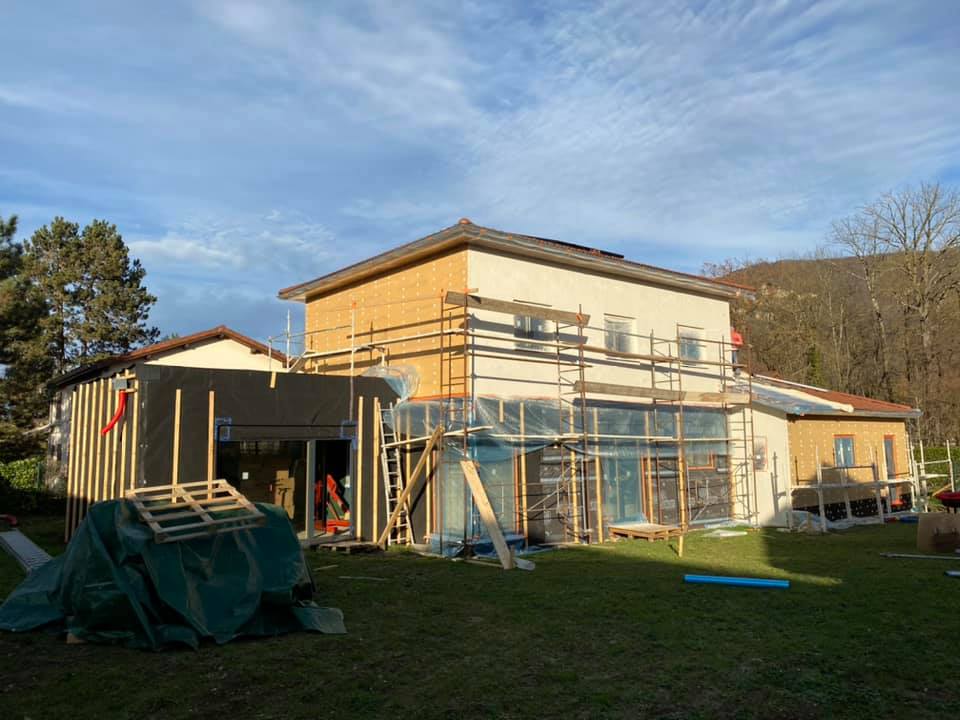
How to finance a self-build
Financing a self-build project is far from simple.
Banks give two reasons:
-
Fear that the house will not conform, or even never be finished
-
Less insurance/guarantees than with a professional (damage to work, ten-year guarantee, good completion guarantee)
Some institutions do not finance this type of project. So take the time to sound out banking institutions.
Furthermore, for some projects, you may have to pay for the construction of a new house.
Moreover, for some banks, it is necessary to have the entire estimate, item by item, upstream. And that the final invoices match those initial quotes exactly.
The process can be quite cumbersome and should not be underestimated. It takes time and energy in a period already busy with the work.
The process can be quite cumbersome and should not be underestimated.
Lastly, follow up regularly on the various releases of funds so that you don't have any cash flow worries.
The banking part is really important, and should not be underestimated: not always easy to reconcile work and administration.
10 tips for building your own timber-frame house
Buy well and get 3 quotes per item
The couple systematically made 3 quotes for each item.
And Julien advises not to hesitate to negotiate with suppliers, ask for a final gesture to work together.
Join a self-builders' association
Learning and sharing with other self-builders will save you a lot of precious time. Exchanging on technical choices, materials chosen, (and galleys) are the best preparation possible.
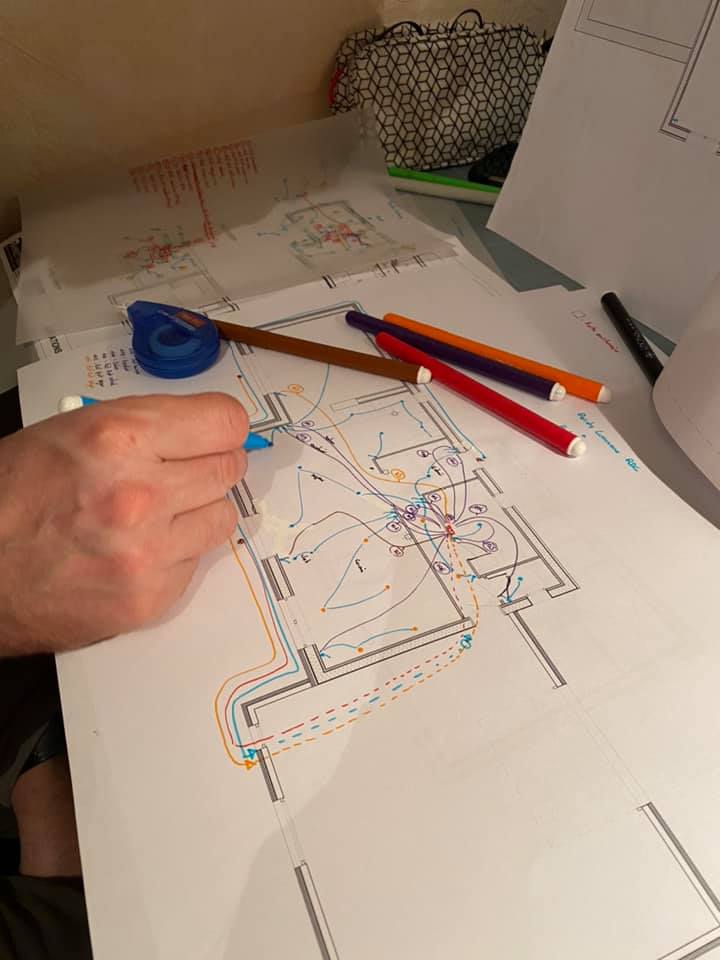
Participatory workcamps
What better way to learn and experience the reality of a self-build project.
This is the best way to gain experience with other self-builders.
Be 100%, both of you, on the project
Such a project leaves no room for a couple where one of them is not 100% motivated.
"You have to be sure that there are two of you who want it," says Julien. 'You have to be sure that there are two of you who want it,' says Julien, 'and both of you have to be willing to put your hand to the work. The project was really shared by the couple, with desires that converged and ideas that complemented each other. Moreover, Mathilde and Julien were able to divide the tasks between them (administrative for her, logistical for him).
.It is necessary to measure the energy that this represents, the management of children if there are any, etc.
Identify his fears, his limits
Starting out on a wooden, self-built house is not a smooth ride.
Fear of having a lack of skills, knowledge, fear of being too hot or too cold in a timber frame house: So many fears to be addressed upstream, which requires a dialogue within the couple.
And thus ensure that everyone is really ready for the project.
Finding accompanying professionals
Some professionals agree to accompany self-builders. The future inhabitants of the home benefit from the advice of the pro, while actively participating in the work.
Of course, the craftsmen are paid. But the owners, while continuing to make progress on their dwelling, benefit from the experience of the craftsmen.
They are paid a fee.
Keeping time out of the project
The couple have saved all their Sundays for themselves. This day is important to take their mind off things, to rest a little, to keep in touch with their loved ones.
The couple kept all their Sundays for themselves.
Monday to Saturday were devoted to construction.
Simplifying the project
Wherever possible, always go for the simplest solution
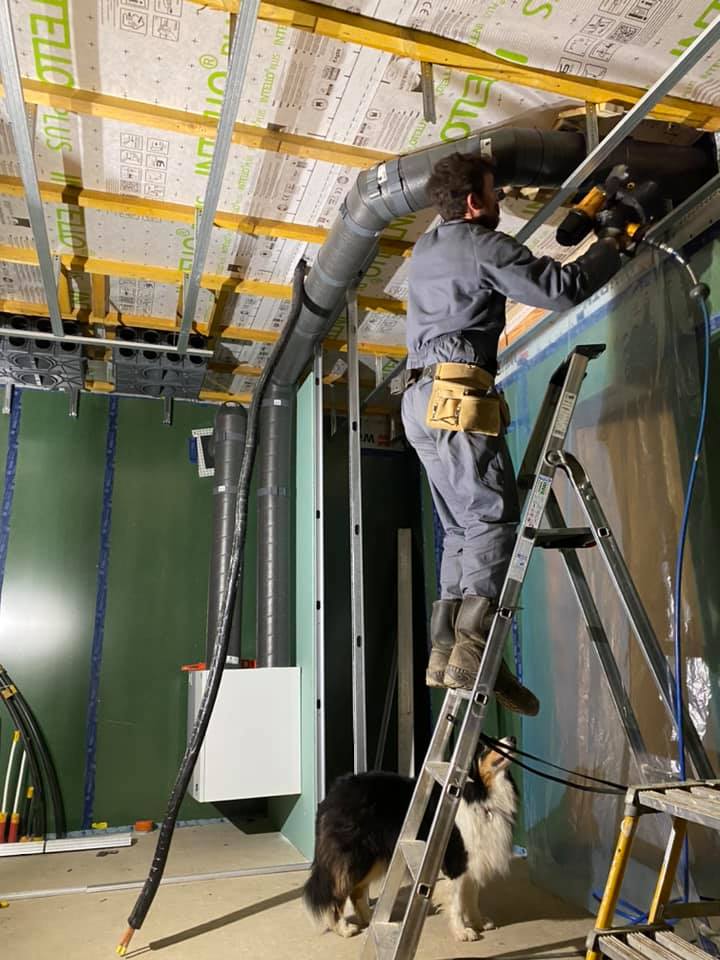
Keep a goal and final timing without putting unnecessary pressure on yourself
Keeping to the overall timing without putting unnecessary pressure on yourself
Additional resources
Youtube
This resource is full of tutorials, tips, dos and don'ts. The trick is to filter the videos well.
Julien found many solutions on this platform, it helped him to unblock some situations.
Books and technical documentation
Julien bought books to fully understand certain topics: insulation, passive house, plasterboard...
Very important to prepare the project, but also to understand well how each step of the construction is done.
A project accessible to all?
Yes! But with a lot of will, patience and energy.
Learn the basics of self-building, join an association, get help.
The ingredients for a successful passive house? Being well surrounded, sure of your motivation and choices (location, choice of materials, ventilation) as well as a very rigorous preparation.
The ingredients for a successful passive house?
Thus, you concretely participate in the preservation of resources, while benefiting from a healthy, economical and efficient home.
I have a passive house project

Find all the photos from the project on this Facebook album

